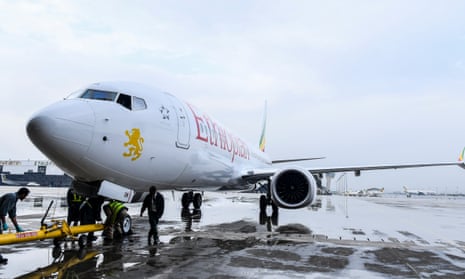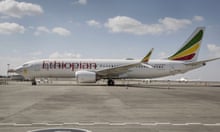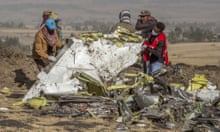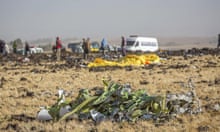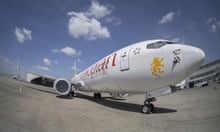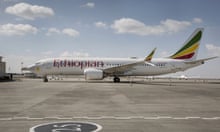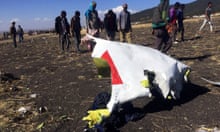The crash of Ethiopian Airlines flight 302 from Addis Ababa to Nairobi is a tragedy that threatens to leave fresh questions hanging over the aircraft manufacturer Boeing.
Few details about the crash are yet available, but according to Ethiopian Airlines the pilot, who was experienced with an excellent flying record, reported difficulties and asked to turn back.
Africa’s aviation safety record has never been good, though Ethiopian has been regarded as an exception. Technical experts from Boeing are standing by for an international investigation into a crash that involved passengers from at least 32 countries.
The Boeing 737 MAX 8, a brand new plane only registered in November, disappeared from the radar six minutes into the flight. Immediate comparisons have been drawn with Lion Air flight 610, which crashed just over four months ago, killing 189 people. Flight data showed erratic climbs and descents before the plane, also a MAX 8, came down 12 minutes after takeoff from Jakarta.
More than 300 Boeing 737-MAX planes are in operation and more than 5,000 have been ordered worldwide since 2017. It is the latest iteration of the 737, the world’s bestselling plane, ever more capable of flying autonomously.
Autonomy, however, can bring problems. It is notable that insurers considering driverless cars worry most about the period when highly autonomous vehicles will coexist with human drivers, the uncertain interface between human and artificial intelligence.
Pilots worldwide were angered after the Lion Air crash that subtle software modifications to the MAX 8’s autopilot had not been fully communicated. Nor were they made the subject of mandatory pilot retraining.
The new plane automatically compensates if it believes its angle puts it at a risk of stalling, a safety feature that worked in a slightly different way to that which 737 pilots were used to. Lion Air’s black box suggested the pilots of flight 610 had been wrestling with this issue.
TimelineBoeing’s 737 Max crisis
Show
The first Boeing 737 Max begins commercial operations with Malindo Air. Norwegian Air is also an early adopter of the new model, operating transatlantic flights. The model promises fuel efficiencies attractive to carriers.
Lion Air flight JT610 crashes after making a sudden, sharp dive into the Java Sea 13 minutes after departing from Jakarta, Indonesia. All 189 people onboard are killed. That particular plane had been in use for less than three months. The plane's black box recorder reveals that the Lion Air plane had experienced problems with its airspeed indicators on its last four flights.
Boeing issues revised instructions on how pilots should react to erroneous readings from “angle of attack” sensors, believed to be a key factor in the Lion Air crash.
Flight ET302 crashes about six minutes after taking off from the Ethiopian capital, Addis Ababa, killing all 157 people onboard. The captain had reported difficulties, and flight radar data shows the aircraft was climbing erratically with an unstable vertical airspeed.
The EU, Canada and the US all ground the Boeing 737 Max. Boeing itself issues a statement saying it “continues to have full confidence in the safety of the 737 Max”, but that “out of an abundance of caution and in order to reassure the flying public” it w recommending the grounding of the entire global fleet of 371 aircraft.
The interim report into the Ethiopian Airlines crash finds that the pilots correctly followed Boeing’s emergency instructions, but were still unable to stop the plane’s nose repeatedly pointing down. The jet hit an airspeed of 500 knots (575mph), well above its operational limits, before cockpit data recordings stopped.
Airlines extend their ban on using the Boeing 737 Max after the US aviation regulator said it had identified a new potential risk with the plane.
In the wake of Boeing’s troubles, Airbus seems set to overtake it as the world's biggest planemaker. As Boeing reported 239 commercial plane deliveries in the first half of the year, a 37% fall, rival Airbus shipped 389 deliveries, up 28% on the same period last year.
Pictures emerge of a Boeing 737 Max due to be delivered to Ryanair with the name 737 Max replaced by 737-8200 on the nose.
During congressional hearings into Boeing’s handling of the crisis, lawmakers were shown internal records revealing that three years before the crashes an employee had expressed concern that an anti-stall flight system could be triggered by a single sensor.
The crisis deepens with the release of hundreds of internal messages between employees working on the 737 Max aircraft, which boasted of deceiving safety regulators and said the plane had been “designed by clowns”.
Boeing orders inspections of its entire fleet of grounded 737 Max planes after it found foreign object debris in the fuel tanks of some of the mothballed planes.
Boeing argued that if pilots followed existing procedures, there should be no danger. Past crashes, however, and most famously the AirFrance flight 447 disaster in the south Atlantic, have shown that the sensors on which aircraft computer systems rely can malfunction, and that pilots who have grown to trust the technology can become rapidly bewildered when things go wrong. All too human reactions led to disaster.
The aviation industry has boasted that it is safer than ever in recent years, and the International Air Transport Association reported no accidents involving a modern commercial passenger jet over several years this decade. Turboprops and old cargo planes might fail, but the worst disasters were ascribed to deliberate acts - terrorist attacks, pilot suicide, Russian missiles – or, in the case of MH370, left unexplained.
Emerging details from Ethiopia may quickly show a specific cause that is completely unrelated to any issues at Lion Air or to the new 737. Boeing and the Federal Aviation Authority, which regulates the company, will hope so. Confidence that a newer plane automatically means a safer plane is in danger of being shaken.
